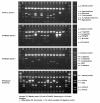Detection of sexually transmitted infection and human papillomavirus in negative cytology by multiplex-PCR
- PMID: 20920170
- PMCID: PMC2956726
- DOI: 10.1186/1471-2334-10-284
Detection of sexually transmitted infection and human papillomavirus in negative cytology by multiplex-PCR
Abstract
Background: The aim of this study was to determine the prevalence of human papillomavirus (HPV) and 15 species that cause sexually transmitted infections (STIs) in negative cytology. In addition, we compared the diagnostic performance of multiplex polymerase chain reaction (PCR) with widely available techniques used to detect HPV.
Methods: We recruited 235 women of reproductive age who had negative cytology findings in a liquid-based cervical smear. STIs were identified by multiplex PCR, and HPV genotypes by multiplex PCR, hybrid capture 2, and DNA microaray; discordant results were analyzed by direct sequencing.
Results: Approximately 96.6% of patients with negative cytology results were positive for pathogens that cause STIs. The pathogens most frequently detected were Gardnerella vaginalis, Ureaplasma urealyticum. The incidence of HPV in negative cytology was 23.3%. Low-risk HPV infection was significantly correlated with Chalmaydia trachomatis, and high-risk HPV infection was significantly correlated with Group β streptococcus. The analytical sensitivities of the multiplex PCR and DNA microarray were higher than 80%, and the analytical specificity was nearly 100% for all tests.
Conclusions: Multiplex PCR yielded results that most of patients with negative cytology were positive for pathogens that cause STIs, and were more similar to that of DNA microarray, than that of hybrid capture 2 in terms of analytical sensitivity and prediction value of HPV infection.
Figures


Similar articles
-
Co-infection of sexually transmitted pathogens and Human Papillomavirus in cervical samples of women of Brazil.BMC Infect Dis. 2017 Dec 15;17(1):769. doi: 10.1186/s12879-017-2835-5. BMC Infect Dis. 2017. PMID: 29246195 Free PMC article.
-
Human papillomavirus detection and typing in thin prep cervical cytologic specimens comparing the Digene Hybrid Capture II Assay, the Roche Linear Array HPV Genotyping Assay, and the Kurabo GeneSquare Microarray Assay.J Virol Methods. 2010 Oct;169(1):154-61. doi: 10.1016/j.jviromet.2010.07.016. Epub 2010 Jul 27. J Virol Methods. 2010. PMID: 20670658
-
Application of a multiplex PCR to cervical cells collected by a paper smear for the simultaneous detection of all mucosal human papillomaviruses (HPVs) and typing of high-risk HPV types 16 and 18.J Med Microbiol. 2010 Nov;59(Pt 11):1303-1310. doi: 10.1099/jmm.0.019240-0. Epub 2010 Aug 5. J Med Microbiol. 2010. PMID: 20688948
-
Overview of human papillomavirus-based and other novel options for cervical cancer screening in developed and developing countries.Vaccine. 2008 Aug 19;26 Suppl 10:K29-41. doi: 10.1016/j.vaccine.2008.06.019. Vaccine. 2008. PMID: 18847555 Review.
-
A review of methods for detect human Papillomavirus infection.Virol J. 2012 Nov 6;9:262. doi: 10.1186/1743-422X-9-262. Virol J. 2012. PMID: 23131123 Free PMC article. Review.
Cited by
-
Co-Infection of Human Papillomavirus with Mycoplasma Hominis/Ureaplasma Urealyticum Among Female Sex Workers in Medan, Indonesia.Open Access Maced J Med Sci. 2019 Oct 14;7(20):3425-3428. doi: 10.3889/oamjms.2019.438. eCollection 2019 Oct 30. Open Access Maced J Med Sci. 2019. PMID: 32002066 Free PMC article.
-
Inflammation on the cervical papanicolaou smear: evidence for infection in asymptomatic women?Infect Dis Obstet Gynecol. 2013;2013:184302. doi: 10.1155/2013/184302. Epub 2013 Sep 24. Infect Dis Obstet Gynecol. 2013. PMID: 24204103 Free PMC article.
-
Service delivery through public health care system to control sexually transmitted infections in Himachal pradesh.Indian Dermatol Online J. 2014 Jul;5(3):271-5. doi: 10.4103/2229-5178.137775. Indian Dermatol Online J. 2014. PMID: 25165642 Free PMC article.
-
A New Multiplex Genetic Detection Assay Method for the Rapid Semi-Quantitative Detection of Six Common Curable Sexually Transmitted Pathogens From the Genital Tract.Front Cell Infect Microbiol. 2021 Aug 23;11:704037. doi: 10.3389/fcimb.2021.704037. eCollection 2021. Front Cell Infect Microbiol. 2021. PMID: 34497776 Free PMC article.
References
-
- Mayar R, Wilbur DC, Solomon D. In: Comprehensive Cytopathology. 3. Bibbo M, Wilbur D, editor. Philadelphia: Saunders; 2008. The Bethesda system for reporting cerical cytology; pp. 77–90.
-
- Boon HE, Gray W. In: Diagnostic Cytopathology. 2. Gray W, McKee GT, editor. London: Churchill Livingstone; 2003. Normal vulva, vagina and cervix: hormonal and inflammatory conditions; pp. 651–705.
-
- McLean NW, Rosenstein IJ. Charaterization and selection of a Lactobacillus species to re-colonize the vagina of women with recurrent bacterial vaginosis. J Med Microbiol. 2000;49:543–552. - PubMed
Publication types
MeSH terms
LinkOut - more resources
Full Text Sources

